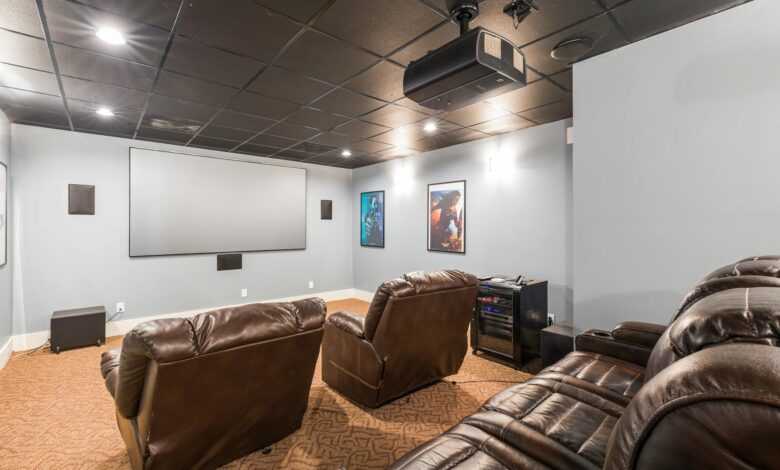
How to Build a Budget-Friendly Home Theater Setup
Creating an immersive home theatre experience doesn’t have to break the bank. With a little creativity and smart shopping, you can assemble a budget-friendly setup that will transform your living room into a personal cinema. Here’s a comprehensive guide to help you build an affordable yet impressive home theatre system.
Step 1: Choose Your Display
The display is the centrepiece of any home theatre setup, and you have two cost-effective options: a projector or a television.
Projector Setup
Projectors offer a massive screen size at a fraction of the cost of a comparably sized TV. For around £500, you can get a high-quality 1080p projector like the BenQ TH685P. This model boasts excellent image quality, 3,500 lumens of brightness, and a long lamp life. To complete the projector setup, you’ll need a projection screen. The Vamvo 120″ 16:9 projector screen is an affordable option at around £50. It’s easy to set up, and its matte white surface ensures a bright and vivid image.
Television Setup
If you prefer a more traditional approach, you can opt for a large-screen television. While high-end models can be expensive, there are plenty of budget-friendly options available. Look for sales and consider last year’s models, which often offer significant discounts. For example, the TCL 55″ 4K UHD Smart TV is a great value option, typically priced around £350. It offers 4K resolution, HDR support, and smart TV capabilities, making it a versatile choice for your home theatre.
Step 2: Enhance Your Audio Experience
While a good display is essential, a home theatre setup wouldn’t be complete without an immersive audio experience. Here are some budget-friendly options to consider:
Soundbar Setup
Soundbars are a convenient and affordable way to upgrade your audio without the hassle of setting up multiple speakers. The Vizio V-Series 5.1 soundbar system is a popular choice, offering 5.1 surround sound for around £250. It’s easy to set up, and its sleek design complements most living room setups. Another excellent option is the Roku Smart Soundbar, which combines a soundbar and a streaming device in one unit. At around £180, it’s a great value proposition, providing decent audio quality and seamless access to your favourite streaming services.
2.1 or 3.1 Speaker Setup
If you’re willing to invest a little more and build your system over time, consider starting with a quality 2.1 or 3.1 speaker setup. The ELAC Debut 2.0 B6.2 bookshelf speakers (around £340) paired with an ELAC subwoofer (around £200) make for an excellent 2.1 system that delivers rich, detailed sound. You can then add rear speakers later to create a full surround sound experience.
Step 3: Choose Your Media Source
To access your favourite movies, TV shows, and music, you’ll need a media source. While Blu-ray players offer the highest quality, they can be expensive. A more budget-friendly option is to use a streaming device like a Roku or an Amazon Fire TV Stick. The Roku Express 4K+ is a great choice, offering 4K HDR streaming and a user-friendly interface for around £40. Alternatively, the Amazon Fire TV Stick 4K is another solid option, priced at around £50.
Step 4: Optimise Your Room
While the hardware is essential, optimising your room for the best viewing and listening experience can make a significant difference. Here are some tips:
Lighting and Acoustics
Darken the room as much as possible by installing blackout curtains or blinds. This will eliminate light interference and create a more immersive viewing experience. To improve acoustics, consider adding a rug or carpet to reduce echoes and improve sound quality. Alternatively, you can strategically place acoustic panels or hang heavy curtains to absorb sound reflections.
Speaker Placement
Proper speaker placement is crucial for achieving optimal sound quality. For a 2.1 or 3.1 setup, position the front speakers at ear level and angle them towards the main listening position. Place the subwoofer in a corner or along a wall for maximum bass impact. If you’re using a soundbar, position it below or above the display, ensuring it’s not obstructed by furniture or other objects.
Seating Arrangement
Arrange your seating in a way that provides a comfortable viewing experience for everyone. Ideally, the main seating position should be centred and at a distance that’s approximately three times the screen size from the display.
Step 5: Accessorise and Personalise
Once you’ve assembled the core components of your home theatre setup, you can add personal touches and accessories to enhance the experience further.
Lighting and Ambiance
Consider investing in bias lighting, which involves placing LED strips behind your display to reduce eye strain and improve contrast. You can also add ambient lighting, such as floor lamps or smart bulbs, to create a cosy and inviting atmosphere.
Seating and Comfort
Upgrade your seating with comfortable recliners or a plush sofa to ensure a relaxing viewing experience. Add throw pillows and blankets for extra cosiness.
Cable Management
Keep your setup organised and tidy by investing in cable management solutions, such as cable sleeves or cable boxes. This will not only improve the aesthetics of your home theatre but also prevent tripping hazards.
Personalised Decor
Add personal touches to your home theatre by incorporating decor elements that reflect your style and interests. This could include movie posters, collectables, or themed artwork.




